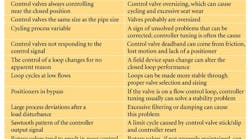Most process industry plants operate at less than maximum efficiency. That is a bold blanket statement, but one that is based on many years of plant site visits to train personnel how to get the most out of their automation systems. Again and again I have seen plants filled with expensive high-technology equipment, computers, control systems and smart devices, yet plenty of operational problems still existed. This article summarizes some major sources of those problems ," improperly tuned control loops, a lack of financial analysis and improperly trained plant personnel ," and outlines the actions necessary to overcome them.
When control loops go bad
Among the conditions that reduce process efficiency are improper control valve selection, sizing or calibration; instability or oscillation above and below the setpoint; slow response to changing conditions; or a combination of these factors. Numerous plant audits have shown roughly one-third of all installed control valves operate at substandard levels, even though properly operating valves are essential to overall plant efficiency and product quality.A study performed by Entech Control Inc., Toronto, identified common problems found in control loops. (See Table 1). Some 80 percent of the control loops studied contributed to increased variability. Table 2 details some common symptoms of control loop problems.Some systems have inherent design deficiencies, but the majority of automation system problems identified by this study stem from lack of human intervention. Most of the problems with control valves, control loops and measurements can be fixed if plant personnel are trained to identify trouble areas and are motivated to make the changes needed for improved performance.Because most companies need to increase profits, it is difficult to understand why more management groups have not empowered their personnel with training and motivation to make the corrections. Some plant officials might mistakenly believe that problems will go away and the process will run at peak efficiency once new high-tech equipment is installed.
Process problem symptoms
Many process engineers look at control valves as low-tech iron that simply controls fluid flow. However, control valves are actually among the most complex field devices. They repeatedly are required to perform rigorous tasks, often under extreme service conditions. Because many control valves are in motion continuously, they can reduce process efficiency drastically if improperly designed, installed and maintained. When a concerted effort is made to understand the performance of these final control elements, process variability can be reduced. Control valves need to respond quickly and accurately to control signals if a corresponding improvement in loop performance is to occur.Another very common symptom is that controllers are placed in manual instead of automatic operation. Although many other reasons could exist, control valve problems are the root cause in many cases.Too few technicians really understand the value of improving loop performance. Although many case studies show better performance of a critical loop produces significant operational benefits, less-obvious problems go unnoticed and unattended. More action is needed for the large number of loops considered less important because improvements made to a large number of these loops could magnify the financial benefit. These improvements become possible and commonplace once plant personnel have the knowledge and skills to troubleshoot problems and implement solutions.Financial return
Most process plants have accounting systems that monitor overall plant costs, wastes and revenues. Major process changes can be tracked to show if an investment resulted in a return to match financial projections. But macro accounting does not provide much help in managing costs on the plant floor or in decision-making at levels affecting overall profitability. In my experience, a micro-management system rarely exists down at the control loop level, yet poorly functioning control loops continue to drain profits.On a single-loop basis, financial returns usually are considered so insignificant that plant management will not invest time or resources to track or attach importance to them. Is anyone in the plant interested in changing a feedstock flow-control loop to reduce the flow setpoint by even a small amount? The answer if probably no, unless plant officials understand the value and make plant improvements a priority.Suppose a finished product flow should be 500 gallons per minute (gpm). If that loop is somewhat unstable or is cycling, plant personnel could lower the setpoint to 499 gpm to avoid exceeding other established limits. What is that 1 gpm worth? At first glance, the flow will change by only 0.2 percent ," seemingly not a big deal. However, if the plant has approximately 500,000 productive minutes a year, multiply the cost of 1 gpm by 500,000 to project the annual return. Do the math to recognize that a significant return is possible from a small change.Financial benchmarking
It is not that difficult for knowledgeable individuals to make changes that influence loop performance. However, once an improvement is made, measurement of the results usually comes in the form of informal and nonspecific comments such as: "Looks good;" "The chart looks better now;" or "The control valve is not moving as much now." These comments do not demonstrate to management the contribution that small improvements are making to the bottom line.The key is to establish financial benchmarks so the financial impact of performance changes on the control loops will be meaningful. The first step is to prioritize all loops, with the most critical loops at the top of the list. Then establish a method to measure the effectiveness of changes to judge results. Apply the most time and resources to improving those at the top. It is very important for plant personnel to identify the measurement objective prior to making changes. Once the measurement strategy has been implemented, payback and ongoing financial benefits can be determined. Possible measurement criteria include: Reduced downtime. Run time can be improved through better maintenance practices and better loop tuning. Reduced feedstock or energy. Feedstock and/or energy consumption can be reduced through better valve operation and improved loop performance. Greater throughput. Greater product throughput might be achieved as a result of higher setpoints without opening relief valves. Better product quality. An improved product should bring a greater return on investment.The human factor
Many technology solutions are available to help improve plant control efficiencies. These include microprocessor-based control systems, smart field devices such as transmitters, and control valves that can diagnose their own faults. In addition, advanced control techniques such as fuzzy logic, neural networks and modeling for complex and interactive loops all go beyond traditional proportional-integral-derivative (PID) control. So why do processing problems continue to plague the industry? The human factor could be the biggest and most neglected contributor to plant inefficiency. Two main issues come into play here. The first is reduced manpower. To lower costs, many companies have reduced technical staff, including instrument and valve technicians, to a minimum. The number is usually just enough to keep the plant running, but not enough to make changes needed to effect improvement. The second issue is inconsistent goals. The goals of management and most process engineers involve plant efficiency improvements to increase profitability. Technician goals generally involve keeping components running. Yet the technicians are the ones who make the changes in the field that materially influence profitability. Too few technicians have profit goals as a part of their job descriptions, so they frequently are not motivated to support management goals. See the figure.How can management get technicians more involved in financial goals? Joe Ruder, instrumentation and electrical engineer at Terra Industries, Sergeant Bluff, Iowa, has some ideas. "We provide performance motivation for our technicians by getting them involved in the decision-making process," says Ruder. "They had the idea to bring in expert process control trainers to help improve plant efficiency. They also participate in a company profit-sharing program based on plant profits."Ruder says this approach provides an incentive for management and technicians to work together to solve problems and improve plant operation. "In addition, management provides an atmosphere of open communications and makes job descriptions consistent with management goals," he says.When Goals Differ, Efficiencies Suffer
The goals of management and most process engineers are to improve plant efficiency and to increase profitability. Technician goals generally involve the maximization of component uptime. Too few technicians have profit goals as a part of their job descriptions, so they frequently are not motivated to support management goals.
Training: a strategy for tough times
Reducing human resources through layoffs or early retirements could be exactly the wrong approach during tough times. What if the workforce were trained to make full use of plant assets? Could profitability be maximized? The best approach during tough times might not be to reduce manpower, but instead to provide training for the existing workforce. If the workforce must be reduced, make sure the remaining personnel are more efficient by giving them the necessary information and honing their skills through training. Then, with measurement systems in place, you can track improvements and identify effects to make management aware of the financial benefit of a well-trained workforce.Most people believe training is a good thing, but have many excuses for not providing it. Some say they are too busy. Others say the budget does not allow training. Still others are afraid that people might leave when they become better trained.All these excuses can be proved faulty. For example, low budgets often are blamed for reducing or eliminating training, but when a production shutdown occurs as the result of poor maintenance, money always can be found to make repairs. The argument about letting veteran workers do the training is just as spurious. Too often, those who have been around for a long time pass on bad information and unwanted habits. In my 18 years as an instructor on technical subjects, older workers are generally less knowledgeable and often less willing to accept new technologies and new methods. Do you really want them training your eager new workers? Training reduces the time required to achieve goals. Training saves time and money on maintenance and improves plant availability. Human resources are the most valuable assets any organization can have. For these resources to be most productive, they must have training, motivation and organization. Egnew is a training consultant covering a wide variety of topics, including control valves, instruments and process control. He was a certified training instructor for Emerson Learning Solutions for 18 years. Contact him at [email protected].

